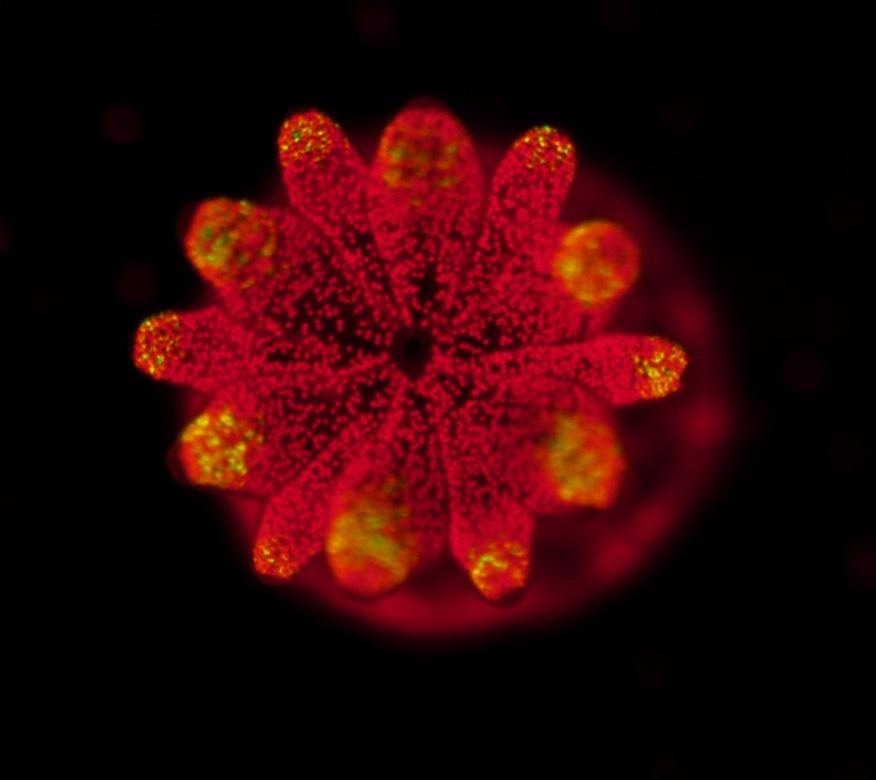Reviewed by Alex SmithMay 3 2022
Corals are the foundation species for ocean and reef ecosystems but coral bleaching due to ocean warming and climate change is destroying them. Recent open-access research by scientists at the University of California, Riverside, aims to offer insight into how to reverse the destruction and save the corals.
 Fluorescence image of one coral Acropora juvenile polyps hosting the symbiotic Symbiodiniaceae (Breviolum minutum) algae that were used in the study, shown as red dots. Green color is the endogenous green fluorescence from corals. Image Credit: Robert Jinkerson/Tingting Xiang.
Fluorescence image of one coral Acropora juvenile polyps hosting the symbiotic Symbiodiniaceae (Breviolum minutum) algae that were used in the study, shown as red dots. Green color is the endogenous green fluorescence from corals. Image Credit: Robert Jinkerson/Tingting Xiang.
Corals, along with jellyfish and sea anemones, belong to a family of animals known as cnidarians that receive a portion of their nutrients via a symbiotic relationship with photosynthetic algae living within their cells.
High ocean temperatures result in a breakdown of the symbiosis leading to a ‘bleached’ coral that has ousted the algae. If symbiosis is not started within a few weeks, the coral will waste away and die.
The new research discovered that although photosynthesis by algae is a core part of the symbiotic association, it is not essential to stimulate symbiosis. The discovery is important to understanding the obscure relationship between cnidarians and algae at the molecular level and sheds light on how to spur the symbiotic relationship between the two organisms after a bleaching event.
It could also result in strategies that might stop warmer oceans from interrupting the symbiotic relationship between the cnidarians and algae, thereby saving the remaining corals of the world.
A mutualistic symbiosis develops between cnidarians and photosynthetic algae from the dinoflagellate family Symbiodiniaceae that live within their host cells. The algae carry out photosynthesis, change carbon dioxide into sugars, and then offer that to their hosts. Certain species of coral are totally dependent on the food they receive from their algal symbionts and will perish without it.
In exchange, the algae receive nutrients such as phosphorus and nitrogen from the prey that the host snares. Photosynthesis is a core activity of this symbiotic association, but there is no information available to determine if this symbiosis can take place without photosynthesis.
Robert Jinkerson, an assistant professor of chemical and environmental engineering at UCR, and Tingting Xiang, an assistant professor of biological sciences at the University of North Carolina at Charlotte, guided a team to create the first mutants in Symbiodiniaceae algae — isolate mutants that could not photosynthesize — and use these mutants to examine symbiosis with cnidarians.
We were very excited to be able to generate six photosynthetic mutants and then use those mutants to start to probe the symbiosis between these algae and their hosts.
Robert Jinkerson, Assistant Professor of Chemical and Environmental Engineering, University of California, Riverside
The researchers added the mutant algae into seawater tanks that held sea anemones (Exaiptasia pallida) that had not yet formed a symbiosis with any algae. After just a day, the algae could already be seen inside the sea anemone’s tentacles, even without photosynthesis.
To investigate if the algae could live in sea anemone host tissue without photosynthesis for greater amounts of time, the team infected a few sea anemones in darkness with mutant and non-mutant algae and preserved them in darkness for 6 months.
Even after 6 months, algal cells could still be seen in the sea anemone’s tissues. Although capable of infecting the host cells and maintaining themselves for 6 months, the algae could not reproduce and multiply in number.
The researchers also investigated four other species of algae known to develop symbiotic relationships with the sea anemones and learned that they too could start symbiosis in the dark.
Jinkerson, Xiang, and their colleague Masayuki Hatta in Japan then added the algae in darkness into a tank holding juvenile polyps of a stony coral, Acropora tenuis. The algae infected the coral effectively in the dark. Surprisingly, the algae could multiply in the coral tissues without photosynthesis, an occurrence not witnessed in the sea anemones.
Finally, to understand if the pattern applied to the third member of the cnidarian group, the team placed the algae in a darkened tank of upside-down jellyfish (Cassiopea xamachana) polyps. Once again, the algae were able to infect the polyps, though not as effectively as in the coral and sea anemone.
Symbiosis formation can take place without photosynthesis in jellyfish, coral and sea anemone hosts, but different facets of the relationship, such as the multiplying of the algae without photosynthesis, relies on the particular host–algae relationship.
Our study highlights the power of forward genetic approaches to probe cnidarian Symbiodiniaceae symbiosis and provides a promising platform to answer key questions in symbiosis and ultimately develop strategies to save corals.
Tingting Xiang, Assistant Professor of Biological Sciences, University of North Carolina, Charlotte
The finding that photosynthesis is not vital to trigger symbiotic relationships is a step toward discovering ways to help cnidarians endure climate change.
Time is of the essence regarding the protection of the coral reefs, and our hope is that these mutants will allow ourselves and others to increase the overall pace towards this goal.
Joseph Russo, Study Co-Author and Doctoral Student, Jinkerson’s Lab, University of California, Riverside
Jinkerson, Xiang, Hatta, and Russo were joined in the study by Casandra R. Newkirk, Andrea L. Kirk, Richard J. Chi, Mark Q. Martindale, and Arthur R. Grossman. The open-access paper is published in the journal Current Biology.
Journal Reference:
Jinkerson, R. E., et al. (2022) Cnidarian-Symbiodiniaceae symbiosis establishment is independent of photosynthesis. Current Biology. doi.org/10.1016/j.cub.2022.04.021.